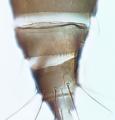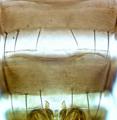Megalurothrips usitatus
Recognition data
Distinguishing features
Both sexes fully winged. Body dark brown, tarsi, apices of mid and hind tibiae, also most of fore tibiae yellow; hind tibiae with 2 stout dark apical setae; fore wings brown with basal quarter pale and an extensive pale area sub-apically. antennal segments I–II brownish yellow, III yellow, IV and sometimes V yellow at base; fore wing light brown, pale sub-basally and with sub-apical pale band. Antennae 8-segmented, I with pair of dorso-apical setae; III–IV with constricted apical neck, sensorium forked, VIII almost twice as long as VII. Head conspicuously transversely striate/reticulate at posterior, ocellar setae III long, arising just inside triangle; postocular setae not long. Pronotum sometimes with transverse carina parallel to posterior margin, median area weakly transversely reticulate; 2 pairs of long posteroangular setae, outer longer than inner, one pair of anteroangular setae moderately prominent. Mesonotum with transverse reticulation, lateral setae not long. Metanotum reticulate medially, median setae long, at anterior margin, campaniform sensilla present. Mesosternal furca with spinula, metafurca without. Tarsi all 2-segmented. Fore wing first vein with long row of setae before distinct sub-apical gap followed by 2 setae; second vein with complete row of setae; postero-marginal cilia wavy. Abdominal tergites II–VIII with no sculpture medially but lateral thirds with sub-parallel lines, median setae small; VIII with postero-marginal comb of small microtrichia laterally, discal area antero-mesead of spiracle with 2 or more rows of strong microtrichia; tergite X with incomplete longitudinal split. Sternites without discal setae, three pairs of long marginal setae, setal pair S1 on VII arise in front of margin. Male similar to female but smaller and paler, pronotum usually yellow; legs sometimes almost yellow; tergite IX with pair of short stout setae posterolaterally; sternites with no pore plates.
Related and similar species
Although 13 species are listed in this genus, all Old World between Africa and the Pacific, the validity of several is open to doubt (Palmer, 1987), particularly some described from China. M. usitatus is the most common and widespread member of the genus, but females are difficult to distinguish from several other named species. The members of Megalurothrips all breed in the flowers of legumes, mainly Fabaceae, but sometimes in Caesalpineaceae or Mimosaceae. The most closely related genera are the Northern Hemisphere genus, Odontothrips and the Australian genus, Odontothripiella. The species in all three genera breed in the flowers of leguminous plants.
Taxonomic data
Current valid name
- Megalurothrips usitatus (Bagnall)
Original name and synonyms
- Physothrips usitatus Bagnall, 1914: 359
- Frankliniella nigricornis Schmutz, 1913: 1020
- Frankliniella obscuricornis Schmutz, 1913: 1022
- Frankliniella vitata Schmutz, 1913: 1023
- Physothrips cinctipennis Bondar, 1916: 217
- Physothrips mjobergi Karny, 1920: 37
- Taeniothrips longistylus Karny, 1922: 22
Family placement
Thripidae, Thripinae
Biological data
Life history
Breeding in flowers
Host plants
Various Fabaceae, including some bean crops.
Tospoviruses vectored
None
Crop damage
Causing yield reduction to several legume crops in Asian countries, including mung bean, groundnuts and soybean.
Distribution data
Area of origin
Oriental region.
Distribution
Widespread and common from India to Japan, northern Australia and Fiji. Recorded from eastern Mediterranean in 2010, and likely to be introduced to California.








